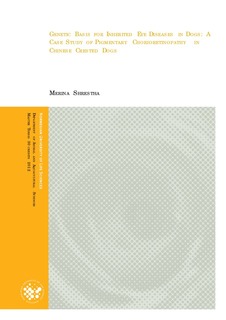| dc.contributor.author | Shrestha, Merina | |
| dc.date.accessioned | 2012-09-10T12:21:49Z | |
| dc.date.issued | 2012-09-10 | |
| dc.identifier.uri | http://hdl.handle.net/11250/186270 | |
| dc.description | As the thesis contains real data and those data is still being used in the process of further confirmation for publication, hence this work shouldn't be published in Barge online database. | no_NO |
| dc.description.abstract | A novel inherited retinal disease, pigmentary chorioretinopathy, has been observed in one of the oldest purebred breed, Chinese crested. Two forms of progressive retinal atrophy (PRA), Progressive rod con degeneration (prcd) and one other form with unknown genetic basis, has already been observed in the breed. This novel retinopathy showed clinical features of progressive nature with bilateral degeneration, migration of lesions from tapetal to non-tapetal and central area in fundus and end stage leading to blindness. A distinct feature of primary defect in retinal pigment epithelium differentiates this disease from PRA. A genome-wide association study with 170K Illumina CanineHD SNP chip was performed using 19 cases and 21 controls. After correcting for population stratification, applying a combined approach of Mixed model and Structured association in R (GenABEL package), an association analysis using 14 cases and 21 controls resulted in a stronge association with two SNPs (P-raw: 4.59e-06 and 5.74e-06) located around 300 kb apart, on chromosome 8. After further analysis in Ensembl (CanFam 2.0), we found that one of the SNPs was located in an intronic sequence of the gene MDGA2 (MAM domain containing glycosylphosphatidylinostitol anchor 2 - 371.42 kb) and the other was located downstream to this gene. MDGA2 is a member of the immunoglobulin superfamily class (IgCAM) and is involved in cell adhesion, migration and recruitment to inflammatory sites. Sequencing of the coding region of MDGA2 revealed a non-synonymous mutation that caused an amino acid shift from “threonine” to “serine”. The sequence analysis was inconclusive; hence more individuals need to be sequenced for a definite conclusion. Also, a manual gene annotation of MDGA2 is required for a mutation to be concluded as not causative. Hence, additional studies need to be performed to unravel the genetic basis of the disease which will guide us to the possible preventing strategy in near future. | no_NO |
| dc.language.iso | eng | no_NO |
| dc.publisher | Norwegian University of life Sciences, Ås | |
| dc.subject | Canine inherited retinal disease | no_NO |
| dc.subject | Retinal Pigment Epithelium | no_NO |
| dc.subject | Pigmentary Chorioretinopathy | no_NO |
| dc.subject | Genome wide association study | no_NO |
| dc.title | Genetic Basis for Inherited Eye Diseases in Dogs : A Case Study of Pigmentary Chorioretinopathy in Chinese Crested Dogs | no_NO |
| dc.type | Master thesis | no_NO |
| dc.subject.nsi | VDP::Agriculture and fishery disciplines: 900::Clinical veterinary science disciplines: 950 | no_NO |
| dc.description.embargo | 2017-12-30 | |
